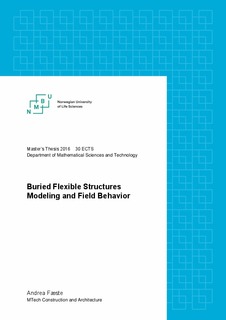| dc.contributor.advisor | Vaslestad, Jan | |
| dc.contributor.author | Fæste, Andrea | |
| dc.coverage.spatial | Norway | nb_NO |
| dc.date.accessioned | 2016-07-27T12:53:06Z | |
| dc.date.available | 2016-07-27T12:53:06Z | |
| dc.date.issued | 2016-07-27 | |
| dc.identifier.uri | http://hdl.handle.net/11250/2397308 | |
| dc.description.abstract | The future utilization of long-span buried structures requires improved theoretical understanding of the constructions. The physical dimensions are increasing and the mechanical features grow more complex. FEM modeling serves as a good tool to explore the earth pressure and the internal forces in the steel structure.
The main goal of t his thesis is to investigate the reliability of FEM modeling compared to short- and long- term measurements, with a main focus on the the pressure distribution and internal forces in the steel structure. To perform the study two existing buried structures in Norway were examined; a horizontal ellipse and an arch footed in concrete. Measurements on the horizontal ellipse included earth pressure and deformation, and measurements on the arch included earth pressure, axial force and moment. The model was contrived in PLAXIS 2D based on theoretical material properties and structure geometry.
The earth pressure on the steel structure will increase in a long-term perspective. It is therefore preferred that the modelled earth pressure coincide this accretion. The results show overall good correspondence. At the ellipse structure the modelled arching effect was higher than measured. Laboratory tests are required in order to achieve a more accurate soil model, thereby improving the results. The modelled axial stress was inverted from the measured axial stress. The measured axial force and moment were also higher than the modelled values. The measurements are based on five locations in the steel structure and it remains unclear whether or not they represent the total stress distribution. It is likely that the modelled values present a better estimation on the stress distribution. However, further investigation and additional measurements are necessary to investigate this assumption. The measurements on deformation suggested that peaking occurred during construction. Controlled peaking in buried structures is desired when the internal stress caused by deformation don’t exceed the yield point. The modelled deformation estimated that the span increased. An alternative solution for obtaining a better estimate is to insert a line-load on each backfill layer in order to imitate the compression performed during backfill.
Overall the model in PLAXIS 2D produced adequate estimations of the earth pressure and internal forces. The detailed monitoring of the construction presented in the model could prove useful in future soil-steel structures. Obtaining a representative model of the selected structures will however require some additional adjustments. | nb_NO |
| dc.description.abstract | For å imøtekomme utfordringer knyttet til fremtidige korrugerte stålkonstruksjoner kreves økt teoretisk forståelse. Dimensjonene blir stadig større og med det blir det byggetekniske mer innviklet. FEM modellering gir et godt verktøy til utforsking av jordtrykk og kraftpåkjenning på stålstrukturen.
Målet med denne masteroppgaven er å teste relabiliteten til FEM modellering sammenlignet med målte verdier. Det er fokusert på interaksjon mellom stålrør og friksjonsmassene og kraftpåkjenningen dette medfører. To eksisterende kulverter i Norge er testet; en kulvert med horisontal ellipse og en med bueform. Målingene på ellipsen inkluderer jordtrykk og deformasjon, og på kulvert med bueform inkluderer jordtrykk, aksialkraft og moment. Modelleringen er utført i PLAXIS 2D. Modellen er basert på teoretiske verdier og geometri.
Målingene viste at jordtrykket økte over tid. Det modellert jordtrykket viste god korrelasjon opp mot de målte verdiene. I kulverten med ellipse viste modellerte verdier høyere ”Arching” effekt enn i de målte resultatene. Dette kan være grunnet de valgte parameterne i friksjonsmassene. Tester utført på friksjonsmassene kan forbedre modellen og derav forbedre resultatene. Den modellerte aksialkrafta og moment samsvarte ikke med de målte verdiene. De målte verdiene representerer spesifiserte korrugeringer i stålkonstruksjonen og det kan diskuteres om dette gir et godt bilde på total kraftdistribusjon. For å undersøke om dette er tilfelle må flere målinger utføres på et større antall korrugeringer. Den målte deformasjonen viser at det var ”peaking” i konstruksjonen under bygging. Det er ønskelig med ”peaking” så fremt ikke deformasjonen fører til flyt i stålet. Den modellerte deformasjonen samsvarte ikke med de målte verdiene. For å bedre modellen foreslås det at at det tilføres linjelast i hvert lag for å imitere tilbakefylling.
Alt i alt ga modellen i PLAXIS 2D gode estimater. Programmet er bygget opp slik at endringer under byggeprosess kan følges, dette gir god kontroll. For å forbedre modellen til de presenterte strukturene kreves enkelte forbedringer som nevnt. | nb_NO |
| dc.language.iso | eng | nb_NO |
| dc.publisher | Norwegian University of Life Sciences, Ås | |
| dc.subject | PLAXIS 2D | nb_NO |
| dc.subject | FEM modeling | nb_NO |
| dc.subject | Long span flexible metal culverts | nb_NO |
| dc.subject | Corrugated steel pipes | nb_NO |
| dc.subject | Long term measurements | nb_NO |
| dc.title | Buried flexible structures : modeling and field behavior | nb_NO |
| dc.type | Master thesis | nb_NO |
| dc.subject.nsi | VDP::Technology: 500::Building technology: 530::Construction technology: 533 | nb_NO |
| dc.source.pagenumber | 74 | nb_NO |
| dc.description.localcode | M-BA | nb_NO |
